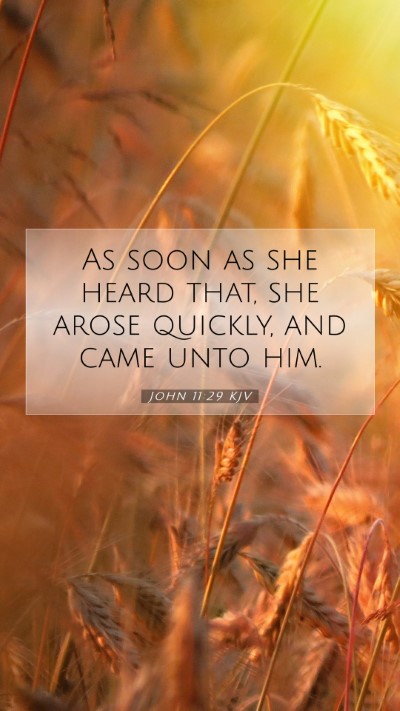Understanding John 11:29 - Bible Verse Meanings and Interpretations
In John 11:29, we find a poignant moment in the narrative of Jesus raising Lazarus from the dead. This verse, as part of a broader story, encapsulates a profound emotional and theological significance. Here, Martha, overwhelmed with grief, is met with a statement from Jesus that not only reflects His compassion but also foreshadows a miracle.
Verse Text
John 11:29 (KJV): "As soon as she heard that, she arose quickly, and came unto him."
Contextual Overview
This verse occurs in the midst of a deeply emotional passage. Lazarus, a dear friend of Jesus, has died, and upon learning of His arrival, Martha quickly rises to meet Him. The verse signifies her desperation for understanding and hope amidst her sorrow.
Commentary Insights
- Matthew Henry: Henry emphasizes Martha's urgency and belief in Jesus. Her quick response illustrates the hope that Jesus could still bring about a change, reflecting the human desire to reach out to the divine in times of distress.
- Albert Barnes: Barnes notes the significance of Martha’s action. He interprets her movement towards Jesus as a sign of her faith and recognition of His power, portraying a vital aspect of biblical faith: the need to approach Christ personally in our sorrows.
- Adam Clarke: Clarke expands on Martha’s character, highlighting her proactive nature. He suggests that her swift response reflects an innate understanding that Jesus is the source of comfort and hope, illustrating a core theme of seeking Jesus in our greatest moments of need.
Thematic Exegesis
The verse presents multiple themes important for Bible study insights:
- Faith in Action: Martha’s quick response signifies a deep-seated faith that motivates believers to act in trust, particularly in situations that seem hopeless.
- Divine Comfort: This verse reassures readers that approaching Jesus in times of trouble is not only appropriate but essential for receiving comfort and answers.
- Resurrection Hope: The unfolding miracle of Lazarus serves as a precursor to the resurrection promise, providing hope for eternal life through Jesus.
Application of John 11:29
Applying the lessons from John 11:29 can take many forms in daily life:
- Seeking Jesus: In times of grief and distress, believers are encouraged to approach Jesus with their burdens, as Martha did.
- Acting in Faith: This passage teaches the importance of swift and decisive action in faith; when one recognizes the presence of Jesus, immediate response is vital.
- Community Support: Martha's action could also represent the importance of reaching out to others, showcasing the communal aspect of faith.
Cross References
- John 11:1-6: The introduction to the narrative of Lazarus’ illness and Jesus’ delayed response.
- John 11:35: “Jesus wept.” This verse highlights Jesus’ empathy and compassion during moments of grief.
- John 14:1-3: Jesus encourages His followers to trust in Him, promising a place in His Father’s house—a direct connection to the hope of resurrection.
Conclusion
In summary, John 11:29 is more than a narrative segment; it embodies profound Bible verse meanings that resonate with the core themes of faith, comfort, and hope. Through careful scripture analysis and Biblical exegesis, we understand that in our most trying times, we are called to rise and approach Jesus. This engagement not only leads us closer to Him but brings clarity and reassurance amid life's challenges.


